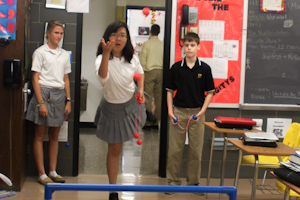The replacement of homeroom with advisory at the end of 2009-2010 was a major change.
Most students were skeptical, but they welcomed the change. Now in its third year, the program has become an integral part of the school day. But it could be better.
The focus of advisory is to “personalize the experience” for students of all grade levels, according to Advisory Program Coordinator Danica Attanasio. Advisory allows students of different classes to intermingle and allows teachers and students to form a special bond. However, this is not always accomplished in the most effective way. Some advisories have better advisee-advisor relationships than others.
This difference comes from the activeness of some advisories. Advisories vary radically and range from the silent 10 students and a teacher advisory sitting in a room to the exciting advisory making a constant ruckus playing games in the hallway. This is a gap that the administration should close.
Some advisories have been seen playing corn hole in the hallway, a game where bean bags are thrown into a hole in a wooden board, having a saltine cracker eating contests, having parties, and hosting a variety of other activities.
There are obviously necessary things that advisories do each day. Events are announced, important papers and memos are handed out, and teachers check up on students. But that does not mean that every day advisory needs to be mundane.
More advisories need to take on an active attitude. In fact, that attitude should be mandatory.
A yearlong advisory tournament should be set up. There could be athletic programs and activities like trivia games. Team building and bonding activities could even be worked into the schedule. Every week, a day should be day set aside for such activities.
If the administration set up this year long competition, it would add advisory and school spirit. Students would get excited about going to advisory. It would make the less active advisories fun and the active advisories even more fun.
Being active and involved would also help some students and advisors open up to each other. One of the main focuses of advisory is to give students a teacher they can talk to. This is not always successful, even in the most advisories.
Students would be more willing to be open with their advisor or each other if they had more activities.
There’s no denying that advisory has been successful in most aspects. Underclassmen and upperclassmen can be seen walking together on a regular basis, an occurrence no doubt helped by the advisory.
In fact in a poll by The Patriot 38.6% of the 317 students polled said they talk to a student in a different grade from their advisory every day and 25.3% students do on a regular basis. And 70.5% of students believe that advisory is a safe place to talk about sensitive issues.
If advisory was more uniformly active and less mundane, it would help to bring those numbers to 100%. Advisory has been a great addition to the JC community, but there are still ways that it can be improved.
Bryan Doherty is an Opinion Editor for The Patriot and jcpatriot.com



